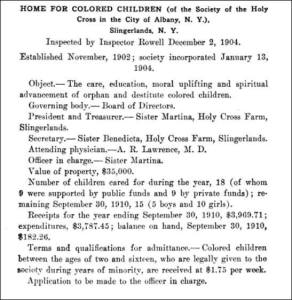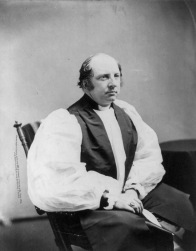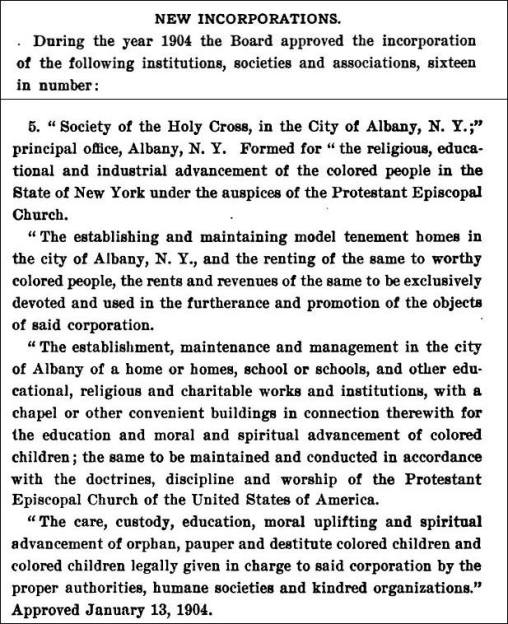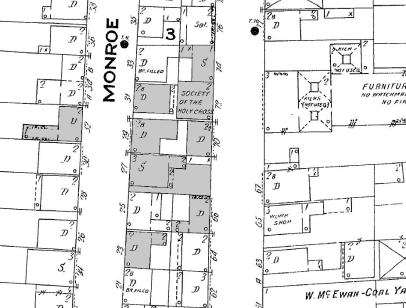Rambles in local history frequently lead to surprises: we go looking for some piece of information, and stumble across something far more interesting. Serendipity struck again last month, when, purely by chance, I learned about an Episcopal orphanage for African-American children in Albany County. And the story was not new to just me: there were no references in either the diocesan history or the history of All Saints Cathedral.
The orphanage’s legal name was The Home for Colored Children, but it was more commonly referred to as Holy Cross Farm. It was located just outside the then city limits on New Scotland Avenue, in the hamlet of Hurstville.
The one full listing we have (from the 1910 Federal census for the town of Bethlehem) shows fifteen African-American children between the ages of two and seventeen. We know from a contemporary newspaper account[1] that it accepted children from across the State of New York. That year, there was a staff of six: a Mother Superior and her assistant, a teacher, cook, and a handyman.
According to a city directory of the period, the Mother Superior, Stella Runyon Martin, was called Sister Martina. Sister Martina was a member of the Sisterhood of the Holy Child Jesus, an order of Episcopal nuns organized by Bishop William Croswell Doane and Mother Helen Dunham in 1873. Sister Martina’s assistant, Winifred Clare Benedict, was known as Sister Benedicta, and likely belonged to the same order.
The orphanage was opened in 1902, and closed in 1914. For all but its first two years, Holy Cross Farm was directed by the Society of the Holy Cross in the City of Albany.
The Society of the Holy Cross was incorporated in 1904. Its officers consisted entirely of Cathedral staff and members: the president was the cathedral’s long-time Canon Precentor, Thomas B. Fulcher, the treasurer a long-time member of the Cathedral congregation, and the secretary was the assistant Cathedral organist. The Society was formed for “the religious educational and industrial advancement of the colored people in the State of New York under the auspices of the Protestant Episcopal Church.” Three activities were planned:
- Rental housing in the city of Albany
- Homes, schools or other institutions in the city of Albany
- Care and custody of orphaned and neglected children
The first of these projects was already under way. According to the history of All Saints Cathedral[2], Sister Martina had inherited houses in Sheridan Hollow and, as a landlord, found a need among African-Americans for suitable rental housing.
The deeds for the properties tell a slightly different story. Sister Martina bought the houses from four different owners in October and November 1903 and assumed two mortgages; she sold the property to the Society of the Holy Cross in March 1904 and they assumed the mortgages. In 1910, the Society mortgaged the houses a second time to provide income for Holy Cross Farm[3]. Sister Martina also encouraged her tenants to join the Cathedral congregation[4]. Among these were two sisters, Georgine and Harriette Lewis.
In a 1910 newspaper article[5], Georgine Lewis is described as a director of the Society, whose offices were located with the rental properties at 27 Monroe Street. Georgine was then a student at the New York State Teachers’ College in Albany; she graduated in 1911 with a B.S., and later earned a master’s degree at the same institution. She was a long-time faculty member of the Washington D.C. Teachers’ College[6]. According to the University at Albany web site, “She was the first African-American to earn a graduate degree from the University and is believed to be the University’s first African-American graduate to become a college faculty member.”[7] Georgine’s younger sister, was no less impressive. Harriette Lewis graduated from the Teachers’ Training School at Albany in 1911[8], and was the first African-American to teach in the Albany Public Schools[9]. Both sisters were members of the Cathedral congregation; Georgine was married there by Canon Fulcher, the president of the Society of the Holy Cross[10].
The Society sold the houses on Orange and Monroe Streets in January 1914 to businessman William J. Stoneman. The houses were demolished in 1924 to build a warehouse which still stands on the site.
The Society’s second project seems never to have been begun. I have been unable to find any reference to any institution other than Holy Cross Farm.
The third project refers to Holy Cross Farm and the work done there. The fact that the houses were mortgaged a second time in 1910 may indicate financial pressure on the small institution. It closed in 1914 for reasons we may never know.
We do know that Bishop Richard Henry Nelson (who succeeded Bishop Doane in 1913) did some pruning of diocesan missions early in his term. It is possible that Holy Cross Farm was one of these. The Farm continues to be mentioned in classified advertisement for a few years, but only as a farm, offering pasturage for horses. The property was sold in three separate lots between 1914 and 1916.
While the orphanage was no more, Sister Martina continued her good works. According to her obituary, she ran a home known as Mission of the Cross on Staten Island for a dozen years, and also worked in Florida. She died at the Convent of St. Anne in Kingston in 1946.[11]
[1] “Local Officials Are Pleased With Holy Cross Home,” The Binghamton Press, 23 March 1912.
[2] George E. DeMille, Pioneer Cathedral: A Brief History of the Cathedral of All Saints, Albany. (Albany: no publisher, 1967), 159.
[3] “Mortgages Its Property: Society of the Holy Cross to Improve Farm for Colored Children,”Albany Evening Journal, 8 Aug 1910.
[4] DeMille, 159.
[5] “Mortgages Its Property: Society of the Holy Cross to Improve Farm for Colored Children,”Albany Evening Journal, 8 Aug 1910
[6] “Mrs. Wilkins Dies; College Teacher,” Albany Times Union, 1 Feb 1970.
[7] “African-Americans at the University at Albany and its Predecessor Institutions – 1858-present” http://www.albany.edu/news/uablackhistory.php retrieved 5 Mar 2016.
[8] Marian I. Hughes, Refusing Ignorance: The Struggle to Educate Black Children in Albany, New York, 1816-1873. (Albany: Mount Ida Press, 1998), 80-81.
[9] “The African Voice in Albany, New York: Harriette Bowie Lewis Van Vranken Remembers” in A.J. Williams-Myers (ed.) On the Morning Tide: African Americans, History and Methodology in the Historical Ebb and Flow of Hudson River Society. (Trenton: Africa World Press, 2003), 119-139.
[10] “Wilkins-Lewis,” Albany Times Union, 24 Aug 1914.
[11] “Sister Martina, 89, Dies in Kingston,” Albany Times Union, 16 Jan 1946.








My Grandfather and 3 of his siblings were on that 1910 Census. Their mother abandoned them because her father did not approve of her dating a white man (William Thornhill, who was from Ireland). My great grandmother and great great grandfather lived on the Shinnecock reservation in Eastern Long Island. She originally had one son by William, his name was Frank. Apparently he was allowed to live on reservation. But my great great grandfather was told if she had any more children by him she would have to leave. William was some type of sailor who was gone all the time. One day she took my grandfather and the other 3 younger siblings to a train station and said I’ll be right back, I am going to get the tickets. She never came back. A police officer came and asked them what are you children waiting on. They said their mother. Thats how they ended up at the home.
LikeLike
What a sad story. Thanks for sharing. Do you know how long your grandfather and his siblings were at Holy Cross Farm?
LikeLike
He told me once they reached a certain age the had to leave. I believe my Aunt Mary left before the rest of them. They all found each other later by the time the great depression ended. He said an older girl came up to him when he and my grandmother were on a cheese line in Harlem and said “you are so cute, whats your name?” and my dad said Robert Thornhill the girl went back to her mom and said that little boy said his name is Thornhill. She was my cousin Cora (Aunt Cora) and Mary’s daughter if I am correct. Heck of a coincidence. My brother just sent this thread to my cousin Derek who is my Aunt Mary’s grandson.
Great Article! I always thought it was a huge orphanage. Too much TV lol.
LikeLiked by 1 person
I assume he was there until it closed as he was the youngest and would have only been 11 in 1914 when the first lot was sold. He was very close to Ethel his sister who was only a year older. She would always come to visit us. My Grandfather died in 1981. My Aunt Ethel lived to be almost 100.
LikeLiked by 1 person